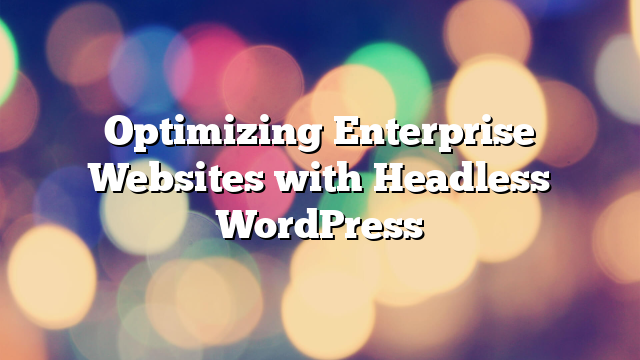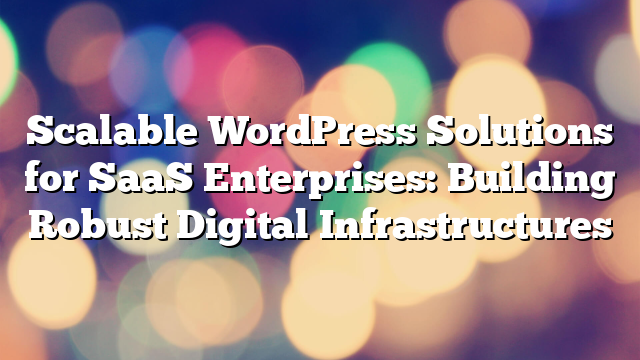Optimizing Enterprise Websites with Headless WordPress
16.12.2024

As enterprises strive to deliver fast, flexible, and engaging digital experiences, traditional content management systems (CMS) sometimes struggle to meet the demands of modern users. This is where Headless WordPress comes in, providing a cutting-edge solution for enterprises looking to optimize their websites. By decoupling the front-end and back-end, Headless WordPress offers unparalleled performance, scalability, and customization. Let’s explore how enterprises can leverage Headless WordPress for their digital transformation.
What is Headless WordPress?
Headless WordPress separates the back-end (content management) from the front-end (user interface). The back-end remains the same WordPress dashboard users are familiar with, but the front-end is built using modern technologies like React, Angular, or Vue.js. Communication between the two is handled through APIs, such as the WordPress REST API or GraphQL.
Key Benefits of Headless WordPress for Enterprises
1. Improved Website Performance
By using JavaScript frameworks for the front-end, Headless WordPress significantly enhances website speed and responsiveness. Faster loading times improve user experience and boost search engine rankings.
2. Greater Customization
Headless WordPress allows developers to build highly customized front-ends tailored to enterprise needs. This flexibility ensures branding consistency while enabling unique and dynamic user experiences.
3. Enhanced Scalability
As enterprises grow, so do their website requirements. Headless WordPress provides the scalability needed to handle increased traffic, complex functionalities, and integration with third-party tools.
4. Omnichannel Content Delivery
With Headless WordPress, enterprises can deliver content across multiple platforms, including websites, mobile apps, smart devices, and kiosks. This ensures a cohesive user experience across all channels.
5. Future-Proof Technology
By adopting modern frameworks and APIs, Headless WordPress positions enterprises at the forefront of digital innovation, ensuring compatibility with emerging technologies and trends.
6. Improved Security
Decoupling the front-end reduces the attack surface, as users no longer directly interact with the WordPress back-end. This minimizes vulnerabilities and enhances overall security.
Use Cases for Headless WordPress in Enterprises
1. High-Traffic Websites
Enterprises running high-traffic websites, such as e-commerce platforms or media outlets, can benefit from Headless WordPress’s ability to handle large volumes of visitors without compromising performance.
2. Multilingual and Regional Sites
Headless WordPress enables seamless management of multilingual or region-specific websites, ensuring consistent branding while accommodating local content requirements.
3. Mobile-First Experiences
With APIs delivering content directly to mobile apps, Headless WordPress ensures fast and optimized experiences for on-the-go users.
4. Custom Web Applications
Enterprises building custom web applications can use Headless WordPress as the content hub, delivering tailored experiences to users while maintaining efficient content workflows.
5. Multi-Platform Campaigns
Marketing campaigns often span multiple platforms. Headless WordPress enables centralized content management while ensuring consistent delivery across all digital touchpoints.
Challenges of Headless WordPress
1. Complexity in Implementation
Setting up and maintaining a Headless WordPress environment requires advanced development skills. Enterprises should consider partnering with experienced developers or agencies.
2. Higher Initial Costs
While Headless WordPress offers long-term benefits, the initial investment in development, hosting, and infrastructure may be higher compared to traditional WordPress setups.
3. Lack of Native Features
Features like themes and plugins designed for traditional WordPress may not work out-of-the-box in a headless setup. Custom solutions are often needed to replicate these functionalities.
4. Maintenance and Updates
Enterprises must manage separate updates for the front-end and back-end, which can increase maintenance efforts.
Best Practices for Implementing Headless WordPress
1. Define Clear Goals
Before adopting Headless WordPress, define specific goals and requirements to ensure the solution aligns with enterprise objectives.
2. Choose the Right Front-End Framework
Select a front-end framework that suits your enterprise’s needs. Popular options include React, Vue.js, and Angular.
3. Optimize API Usage
Efficient API calls are critical to maintaining performance. Use caching and asynchronous processing to minimize load times and reduce server strain.
4. Invest in Robust Hosting
Choose hosting providers optimized for headless setups, offering high performance, scalability, and security.
5. Prioritize Security
Implement strong security measures, such as API authentication, SSL certificates, and regular audits, to protect your content and infrastructure.
6. Test and Monitor
Conduct thorough testing to ensure your Headless WordPress setup meets performance, functionality, and security requirements. Continuously monitor for issues and optimize as needed.
Conclusion
Headless WordPress offers enterprises a powerful way to optimize their websites for performance, scalability, and flexibility. By decoupling the back-end and front-end, businesses can deliver exceptional user experiences across multiple platforms. While the transition to Headless WordPress requires careful planning and expertise, the long-term benefits make it a worthwhile investment for enterprises aiming to stay ahead in the digital landscape.
Interested in exploring Headless WordPress for your enterprise? Contact AllWebDev today to learn how we can help you implement this transformative solution.



